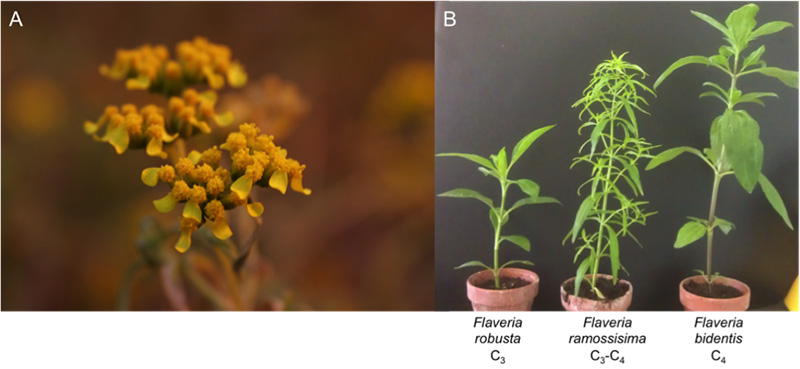The genus Flaveria – our model to study the evolution of C4 photosynthesis
The genus Flaveria belongs to the Asteracean family, more widely known as composite plants. The English common name for Flaveria is yellowtop, referring to their small yellow flowers (see figure A). In nature they can be found, depending on the species, in North and South America, Australia, Asia and Africa.
Why is this genus now interesting for our studies, what makes it special?
C4 photosynthesis is a special and very efficient form of photosynthesis. C4 photosynthesis occurred in at least 66 lineages among the plant kingdom independently (Sage et al., 2012). One can therefore assume that the evolution from C3 to C4 photosynthesis was rather easy in biological terms. To study these changes the plant genus Flaveria functions as one of our favourite models. One of the major benefits of this genus is that it not only contains C3 and C4 species, but also a range of species that exhibit an intermediate type of photosynthesis. One example for a species of each type of photosynthesis can be seen in figure B. This allows us to analyze the changes a plant has to undergo in the transition from C3 to C4 photosynthesis.
Physiological analyses were conducted already many years ago and led to the characterization of the photosynthesis type of the different species. The phylogeny of the Flaveria species was molecularly analyzed in detail (McKown et al., 2005). Recently the transcriptomes of nine Flaveria species were published (Mallmann et al., 2014) thereby providing us with the information of all transcribed genes at a given time. In addition one of the C4 species, Flaveria bidentis, is transformable with the soil bacterium Agrobacterium tumefaciens, i.e. we can implant new genes in these plants and thus the molecular tools are becoming more numerous.

(A) Detail of the flowers of Flaveria ramossisima (C3-C4) showing the yellow colour and the single ray flower per head. (B) Plant habitus of the C3 species Flaveria robusta, the intermediate species Flaveria ramossisima and the C4 species Flaveria bidentis. The shown plants are seven weeks old and were grown together in the green house.
Taken together this gives us new ways and means to understand the transition from C3 to C4 photosynthesis. This will help us to come closer to one of the goals CEPLAS wants to accomplish, namely to alter a C3 plant into a C4 plant.
Contribution by Stefanie Schulze, Heinrich Heine University
Planter’s Punch
Under the heading Planter’s Punch we present each month one special aspect of the CEPLAS research programme. All contributions are prepared by our young researchers.
Corresponding publications
Mallmann J, Heckmann D, Brautigam A, Lercher MJ, Weber AP, Westhoff P, & Gowik U (2014) The role of photorespiration during the evolution of C4 photosynthesis in the genus Flaveria. eLife 3:e02478. [Abstract]
McKown AD, Moncalvo JM, & Dengler NG (2005) Phylogeny of Flaveria (Asteraceae) and inference of C4 photosynthesis evolution. American journal of botany 92(11):1911-1928. [Abstract]
Sage RF, Sage TL, & Kocacinar F (2012) Photorespiration and the evolution of C4 photosynthesis. Annual review of plant biology 63:19-47. [Abstract]